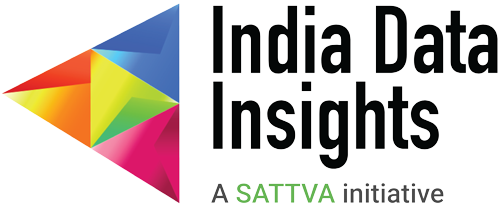SDG 1 – No Poverty
SDG 1 – No Poverty
Published on :- November 3rd, 2022
Poverty has been a long-standing issue in many countries, and it is one that India continues to fight despite significant economic growth over the last three decades. Looking to the future, India has highlighted 7 key targets to achieve by 2030 to reach 'No Poverty':- Eradicating extreme poverty by ensuring every person has at least USD 1.25 (INR 93~) to live on.
- Reduce the proportion of men, women, and children living in poverty by at least half.
- Implement nationally appropriate social protection systems and measures for all.
- Ensure that all men and women, in particular the poor and the vulnerable, have equal rights to economic resources, as well as access to essential services, ownership and control over land and other forms of property, inheritance, natural resources, appropriate new technology, and financial services, including microfinance Build the resilience of the poor and those in vulnerable situations and reduce their exposure and vulnerability to climate-related extreme events and other economic, social, and environmental shocks and disasters.
- Ensure significant mobilization of resources from a variety of sources, including through enhanced development cooperation, to provide adequate and predictable means for developing countries, in particular, least developed countries, to implement programs and policies to end poverty in all its dimensions.
- Create sound policy frameworks at the national, regional, and international levels, based on pro-poor and gender-sensitive development strategies, to support accelerated investment in poverty eradication.
National & International Poverty Lines
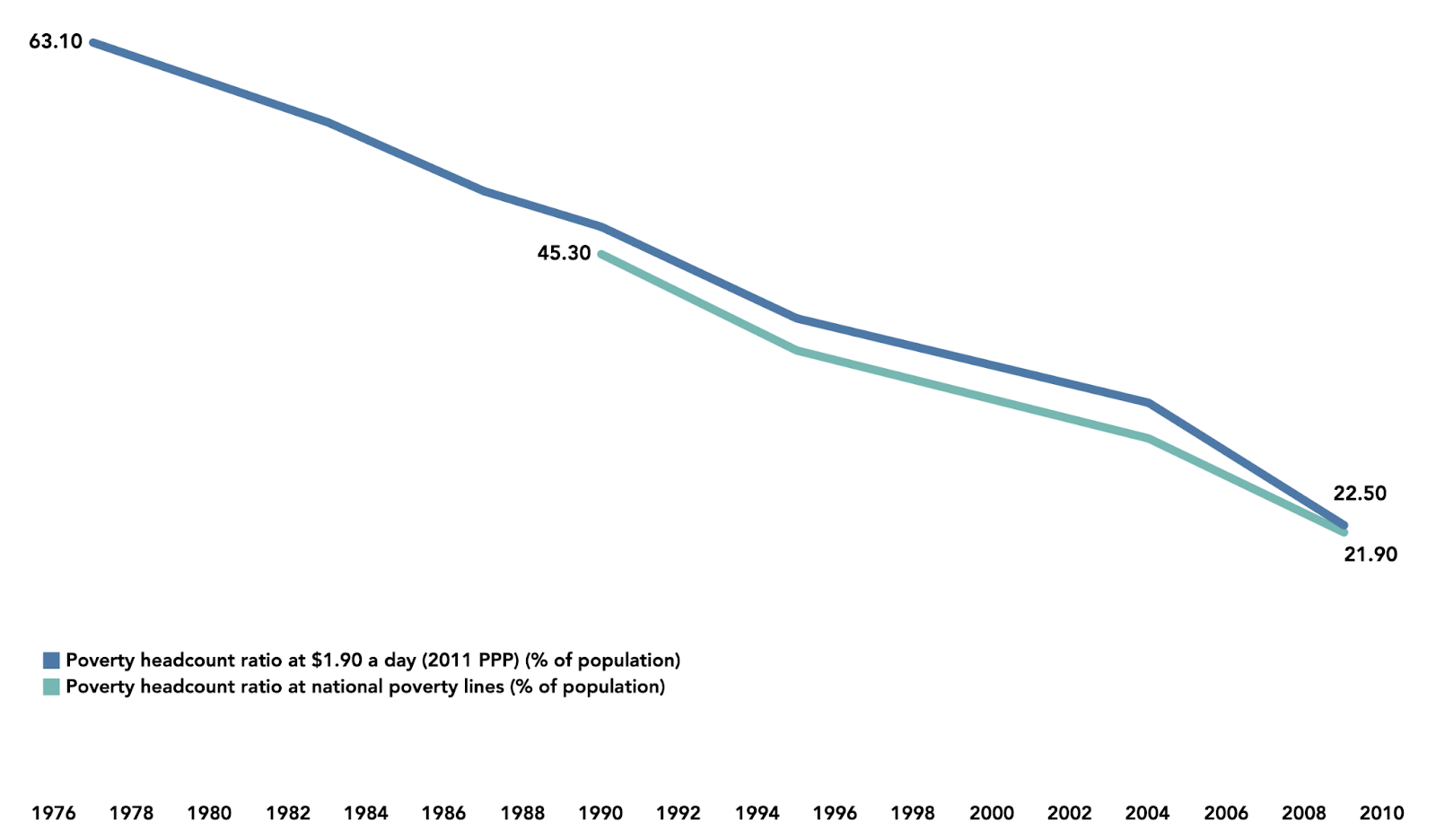 From this data, it is evident that a decline in poverty is clearly visible from the poverty headcount ratio (the percentage of the population living below the poverty line) at both the national and international levels. Based on international data, the percentage of the population living below the poverty line in 1976 was 63.10%, a number that has declined to 22.5% around 2010. National data also shows similar findings, with poverty levels dropping from 45.3% in 1988 to 21.90% in 2010, closing the gap to the millennium development goal that was set prior to the SDGs. This is an excellent sign as the country has surpassed its target in this area.
From this data, it is evident that a decline in poverty is clearly visible from the poverty headcount ratio (the percentage of the population living below the poverty line) at both the national and international levels. Based on international data, the percentage of the population living below the poverty line in 1976 was 63.10%, a number that has declined to 22.5% around 2010. National data also shows similar findings, with poverty levels dropping from 45.3% in 1988 to 21.90% in 2010, closing the gap to the millennium development goal that was set prior to the SDGs. This is an excellent sign as the country has surpassed its target in this area.
Gini Index & Poverty Gap
 A similar trend is visible in the poverty gap (ratio by which the mean income of the poor falls below the poverty line) compared to poverty lines (half the median household income of the total population), as tracked by the United Nations World Population Prospects and Indian Census. The poverty gap reduced from 21.8% in 1976 to 4.6% in 2010. While this move is in the right direction, the range of inequality across India has increased. The GINI index shows a rise from 32.10 in the early 1980s to 35.70 in 2010, reflecting growing economic differences.
A similar trend is visible in the poverty gap (ratio by which the mean income of the poor falls below the poverty line) compared to poverty lines (half the median household income of the total population), as tracked by the United Nations World Population Prospects and Indian Census. The poverty gap reduced from 21.8% in 1976 to 4.6% in 2010. While this move is in the right direction, the range of inequality across India has increased. The GINI index shows a rise from 32.10 in the early 1980s to 35.70 in 2010, reflecting growing economic differences.
State-wise and Multidimensional Poverty levels
The economic inequality across the country can be better understood by looking at Reserve Bank of India (RBI) data on a state-to-state basis. Here, we found that while poverty has decreased drastically since 1990, the variation in GDP across states is significant, with central and eastern India performing the poorest, while smaller and southern states showing increased GDP.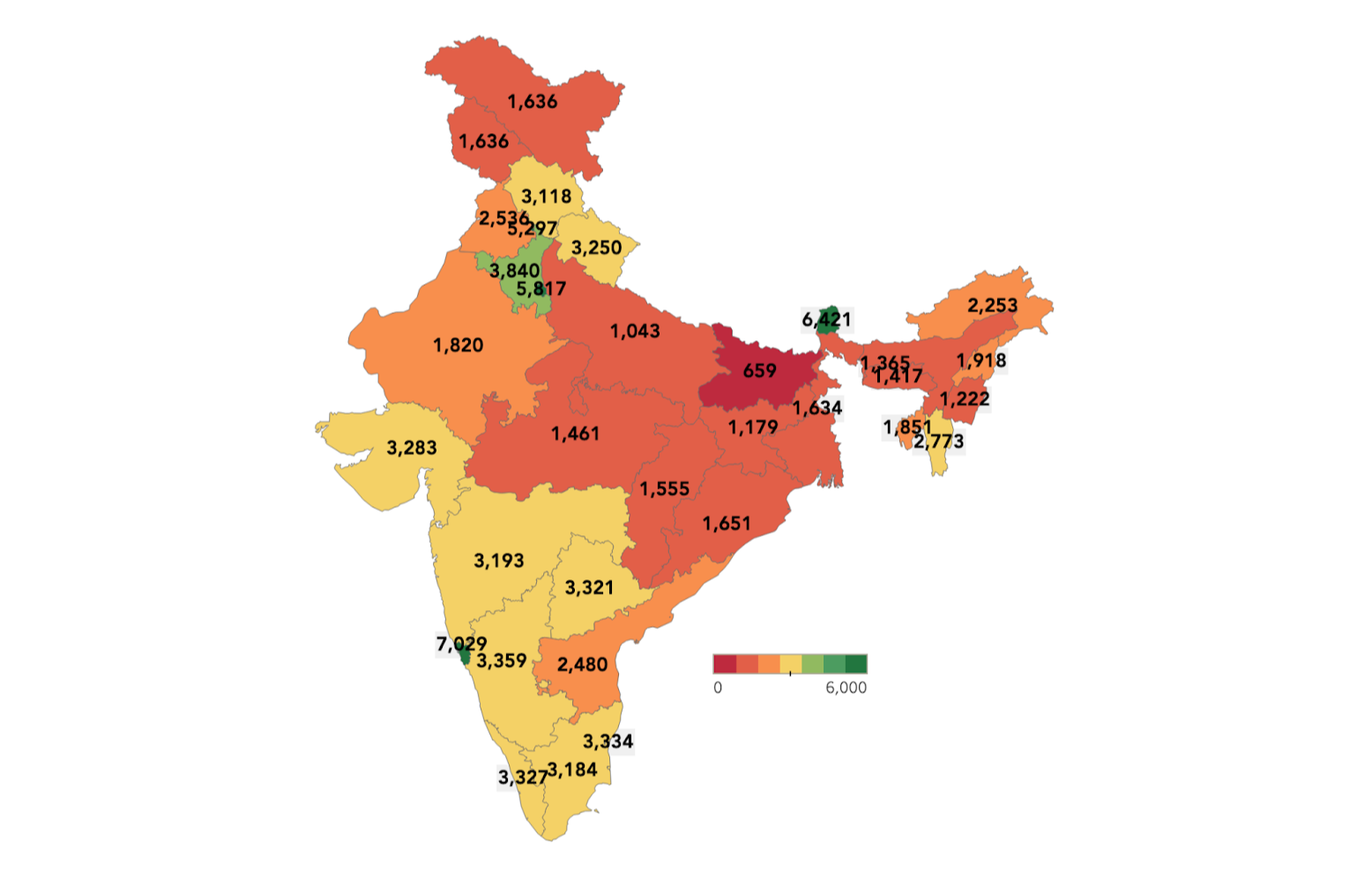 The gap in GDP amongst states is also reflected in the multidimensional poverty data from the UNDP, which conveys the levels of poverty with greater nuance. It encompasses the various deprivations experienced by the poor in their daily lives – such as poor health, lack of education, inadequate living standards, disempowerment, poor quality of work, the threat of violence, and living in areas that are environmentally hazardous, among others. The percentage of the population considered to be multidimensionally poor is higher in states with low GDP. In September 2021, India ranked 62nd among 107 countries in multidimensional poverty.
The gap in GDP amongst states is also reflected in the multidimensional poverty data from the UNDP, which conveys the levels of poverty with greater nuance. It encompasses the various deprivations experienced by the poor in their daily lives – such as poor health, lack of education, inadequate living standards, disempowerment, poor quality of work, the threat of violence, and living in areas that are environmentally hazardous, among others. The percentage of the population considered to be multidimensionally poor is higher in states with low GDP. In September 2021, India ranked 62nd among 107 countries in multidimensional poverty.
% of people who are multidimensionally poor (2020)
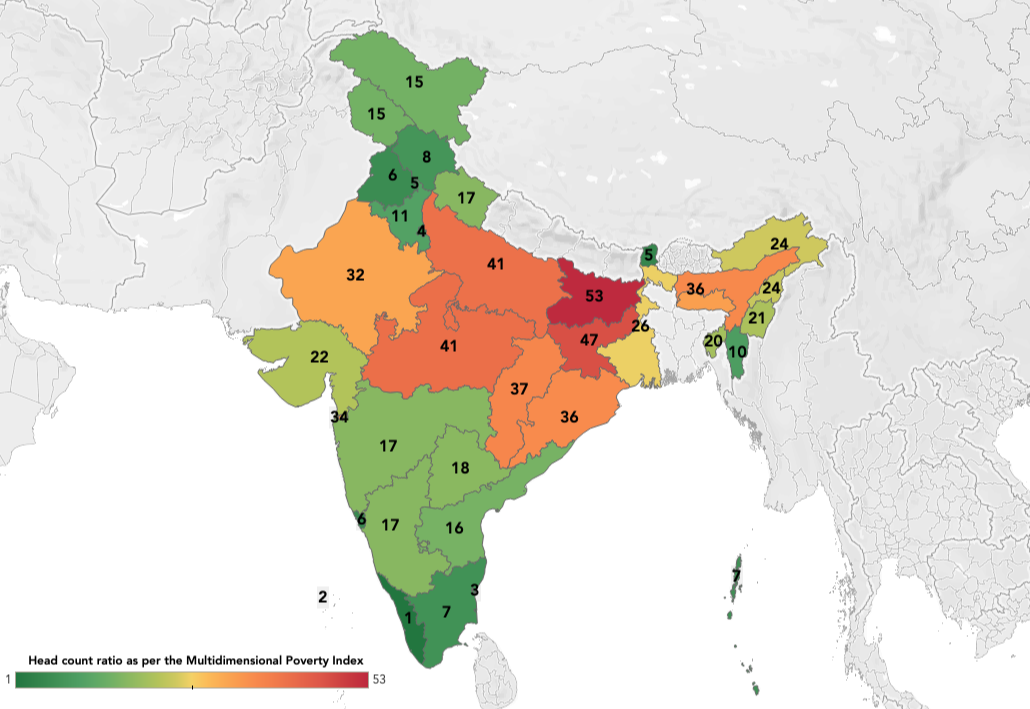 As of 2020, 99.10% of rural homes and 95.7% of urban homes had access to electricity. Similar trends are visible in terms of improved drinking water sources where 98.7% of Rural homes and 94.6% of Urban homes have been found to have access. Sanitation was found to be the most lacking with only 81% of Rural and 64.9% of Urban homes having improved sanitation.
As of 2020, 99.10% of rural homes and 95.7% of urban homes had access to electricity. Similar trends are visible in terms of improved drinking water sources where 98.7% of Rural homes and 94.6% of Urban homes have been found to have access. Sanitation was found to be the most lacking with only 81% of Rural and 64.9% of Urban homes having improved sanitation.
Electricity, Water, Sanitation & Housing
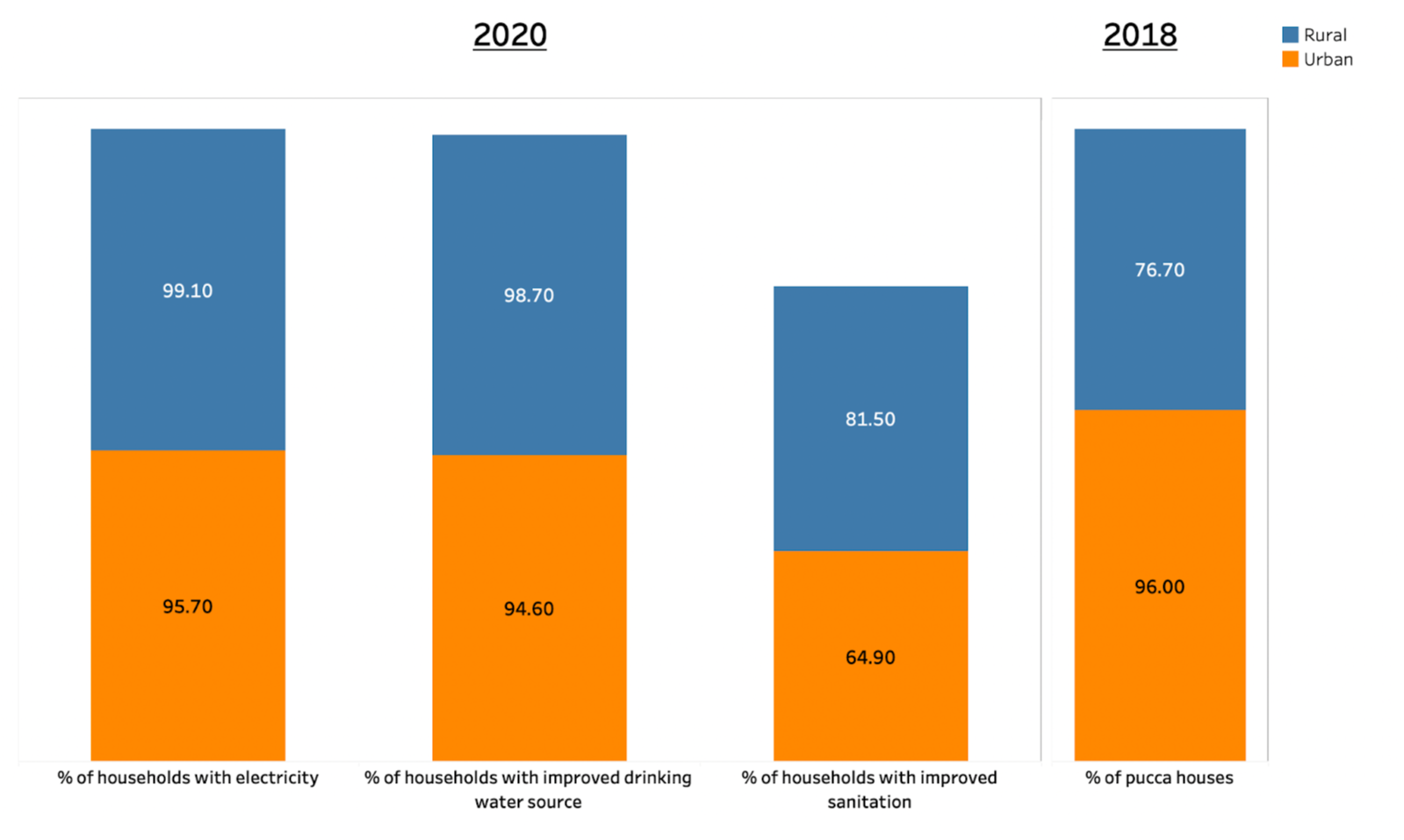 Government’s flagship programmes for poverty alleviation
In addition to economic poverty, access to basic services is crucial in determining quality of life. India still falls short by the 100% coverage target for basic services. Consequently, numerous programmes are currently in place to help elevate the population out of poverty. The PM Jan Dhan Yojana is one of these initiatives which aims to expand affordable access to financial services. Over the last five years, this programme has seen a steep rise in participation, increasing four-fold in the country with two-thirds of participants coming from rural India. Such programmes can help those in need of bank accounts, remittances, credit, insurance, and pensions, and is crucial in the efforts to reduce the poverty gap.
Alongside efforts to improve financial literacy among the population, social inclusion initiatives also play a significant role in reducing India’s population that is in poverty.
Health care is one such factor and is comprehensively tracked by the National Family and Health Survey. As per recent and most comprehensive data, only 28.7% of the population has been covered by health schemes and insurance, with state-wise trends reflecting the state GDP, except for Andhra Pradesh, which has the highest health insurance coverage.
Government’s flagship programmes for poverty alleviation
In addition to economic poverty, access to basic services is crucial in determining quality of life. India still falls short by the 100% coverage target for basic services. Consequently, numerous programmes are currently in place to help elevate the population out of poverty. The PM Jan Dhan Yojana is one of these initiatives which aims to expand affordable access to financial services. Over the last five years, this programme has seen a steep rise in participation, increasing four-fold in the country with two-thirds of participants coming from rural India. Such programmes can help those in need of bank accounts, remittances, credit, insurance, and pensions, and is crucial in the efforts to reduce the poverty gap.
Alongside efforts to improve financial literacy among the population, social inclusion initiatives also play a significant role in reducing India’s population that is in poverty.
Health care is one such factor and is comprehensively tracked by the National Family and Health Survey. As per recent and most comprehensive data, only 28.7% of the population has been covered by health schemes and insurance, with state-wise trends reflecting the state GDP, except for Andhra Pradesh, which has the highest health insurance coverage.
Health Schemes/Health Insurance (2016)
 Other such social inclusion programmes include the Mahatma Gandhi National Rural Employment Guarantee Act, 2005, which provides at least 100 days of guaranteed wage employment in a financial year to every rural household whose adult members volunteer to do unskilled manual work. The number of people allotted work through the MGNREGA has witnessed a slight increase from 2011 to 2020 and a steep increase by over 60% between 2020 and 2021 due to the pandemic. Overall, the scheme has fulfilled the demands of more than 99% of the applicants consistently.
Other such social inclusion programmes include the Mahatma Gandhi National Rural Employment Guarantee Act, 2005, which provides at least 100 days of guaranteed wage employment in a financial year to every rural household whose adult members volunteer to do unskilled manual work. The number of people allotted work through the MGNREGA has witnessed a slight increase from 2011 to 2020 and a steep increase by over 60% between 2020 and 2021 due to the pandemic. Overall, the scheme has fulfilled the demands of more than 99% of the applicants consistently.
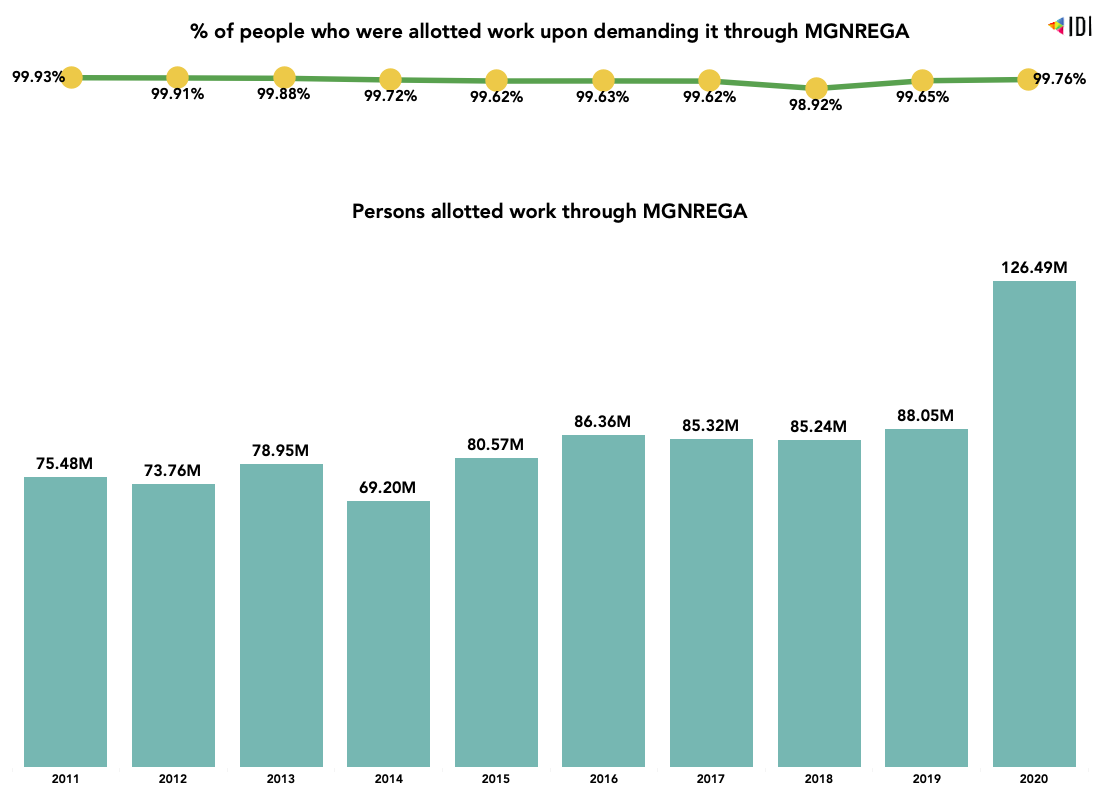 Corporate Contribution
In the private sector, CSR has played a significant role in enabling social impact programmes since 2014. While poverty is rarely seen as a primary focus, the funding of other thematic areas such as hunger, health, education, and skilling help to bridge the poverty gap within the nation.
Community development programmes such as those set up by ONGC, Indian Oil, Infosys, and Bajaj Auto among others play a significant role in bridging the poverty gap. Addition ally, projects such as the health care camps and the Construction of Skill Training Institutes by Larsen & Toubro, the construction of hospitals by Cadila Health care, and the construction of toilets by ONGC, all go towards helping bridge the poverty gap while improving the quality of life across India.
Through the efforts of social inclusion programmes, India has been able to consistently reduce the number of people under poverty. Using data such as the varying GDP and its accompanying impact on multidimensional poverty, both government organizations and corporates have the opportunity to direct their collaborated efforts to support these regions with the greatest need and help eradicate poverty in India.
For more data related assets on SDG 1 - Click Here
Corporate Contribution
In the private sector, CSR has played a significant role in enabling social impact programmes since 2014. While poverty is rarely seen as a primary focus, the funding of other thematic areas such as hunger, health, education, and skilling help to bridge the poverty gap within the nation.
Community development programmes such as those set up by ONGC, Indian Oil, Infosys, and Bajaj Auto among others play a significant role in bridging the poverty gap. Addition ally, projects such as the health care camps and the Construction of Skill Training Institutes by Larsen & Toubro, the construction of hospitals by Cadila Health care, and the construction of toilets by ONGC, all go towards helping bridge the poverty gap while improving the quality of life across India.
Through the efforts of social inclusion programmes, India has been able to consistently reduce the number of people under poverty. Using data such as the varying GDP and its accompanying impact on multidimensional poverty, both government organizations and corporates have the opportunity to direct their collaborated efforts to support these regions with the greatest need and help eradicate poverty in India.
For more data related assets on SDG 1 - Click Here 